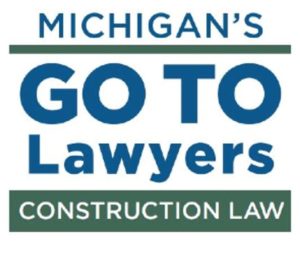After being shut down since Governor Whitmer issued Executive Order 2020-21 on March 23, 2020, Michigan commercial and residential contractors can go back to work effective 12:01 a.m. on Thursday, May 7, pursuant to the Governor’s most recent Executive Order, 2020-70, issued late afternoon on May 1.
More specifically, §10 (f) of EO 2020-70 provides:
Effective at 12:01 am on May 7, 2020, workers in the construction industry, including workers in the building trades (plumbers, electricians, HVAC technicians, and similar workers), subject to the enhanced social-distancing rules described in section 11(i) of this order.
In their haste to get back to work, though, members of the construction industry and trades should not assume that all they need to do is to comply with §11(i) of EO 2020-70, though. That is because §11(i) incorporates by reference all of the requirements set forth in sections (a) through (h) of that section of the Executive Order.
Construction Companies Must Satisfy 19 Requirements to Resume Construction Activities
- Develop a COVID-19 preparedness and response plan, consistent with recommendations in Guidance on Preparing Workplaces for COVID-19, developed by the Occupational Health and Safety Administration and available here. Such plan must be available at company headquarters or the worksite. 11(a).
- Restrict the number of workers present on premises to no more than is strictly necessary to perform the in-person work permitted under this order. 11(b).
- Promote remote work to the fullest extent possible. 11(c).
- Keep workers and patrons who are on premises at least six feet from one another to the maximum extent possible. 11(d).
- Increase standards of facility cleaning and disinfection to limit worker and patron exposure to COVID-19, as well as adopting protocols to clean and disinfect in the event of a positive COVID-19 case in the workplace. 11(e).
- Adopt policies to prevent workers from entering the premises if they display respiratory symptoms or have had contact with a person with a confirmed diagnosis of COVID-19. 11(f).
- Adopt any other social distancing practices and mitigation measures recommended by the CDC. 11(g).
- Businesses or operations whose in-person work is permitted under sections 10(c) through 10(f) of this order must also:
a. Prohibit gatherings of any size in which people cannot maintain six feet of distance from one another.
b. Limit in-person interaction with clients and patrons to the maximum extent possible, and barring any such interaction in which people cannot maintain six feet of distance from one another.
c. Provide personal protective equipment such as gloves, goggles, face shields, and face masks as appropriate for the activity being performed.
d. Adopt protocols to limit the sharing of tools and equipment to the maximum extent possible and to ensure frequent and thorough cleaning of tools, equipment, and frequently touched surfaces. 11(h).
- Designate a site-specific supervisor to monitor and oversee the implementation of COVID-19 control strategies developed under subsection (a) of this section. The supervisor must remain on-site at all times during activities. An on-site worker may be designated to perform the supervisory role.11(i))(2).
- Conduct a daily entry screening protocol for workers and visitors entering the worksite, including a questionnaire covering symptoms and exposure to people with possible COVID-19, together with, if possible, a temperature screening.11(i))(3).
- Create dedicated entry point(s) at every worksite, if possible, for daily screening as provided in subprovision (3) of this subsection, or in the alternative issue stickers or other indicators to workers to show that they received a screening before entering the worksite that day.11(i))(4).
- Require face shields or masks to be worn when workers cannot consistently maintain six feet of separation from other workers.11(i))(5).
- Provide instructions for the distribution of personal protective equipment and designate on-site locations for soiled masks.11(i))(6).
- Encourage or require the use of work gloves, as appropriate, to prevent skin contact with contaminated surfaces.11(i))(7).
- Identify choke points and high-risk areas where workers must stand near one another (such as hallways, hoists and elevators, break areas, water stations, and buses) and control their access and use (including through physical barriers) so that social distancing is maintained.11(i))(8).
- Ensure there are sufficient hand-washing or hand-sanitizing stations at the worksite to enable easy access by workers.11(i))(9).
- Notify contractors (if a subcontractor) or owners (if a contractor) of any confirmed COVID-19 cases among workers at the worksite.11(i))(10).
- Restrict unnecessary movement between project sites.11(i))(11).
- Create protocols for minimizing personal contact upon delivery of materials to the worksite.11(i))(12).
(The bold italicized cites are to the applicable sections of EO 2020-70, found at https://www.michigan.gov/documents/whitmer/EO_2020-70_Emerg_order_-MI_Safe_Start_689217_7.pdf).
The State of Michigan remains under a declared state of emergency due to the COVID pandemic, but Governor Whitmer has expressed her desire to systematically ease the “Stay Home Stay Safe” limits that were set by EO 2020-21. This EO is the next step in the process of allowing Michigan residents to return to the workforce. Obviously, though, each step will involve a heavy emphasis on protecting the health and safety of Michigan workers and the general public.
Should you have any questions about what work may or may not be covered under this exception to the Executive Order, or for more information regarding Rhoades McKee’s construction services, please contact a member of the Rhoades McKee Construction Law Team.
More Publications


